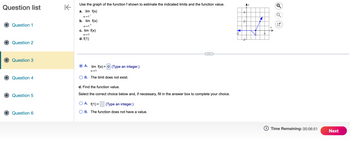Use the graph of the function f shown to estimate the indicated limits and the function value. a. lim f(x) x-1 b. lim f(x) x-1* c. lim f(x) d. f(1) 2 2 ✓ ✓
Use the graph of the function f shown to estimate the indicated limits and the function value. a. lim f(x) x-1 b. lim f(x) x-1* c. lim f(x) d. f(1) 2 2 ✓ ✓
Calculus: Early Transcendentals
8th Edition
ISBN:9781285741550
Author:James Stewart
Publisher:James Stewart
Chapter1: Functions And Models
Section: Chapter Questions
Problem 1RCC: (a) What is a function? What are its domain and range? (b) What is the graph of a function? (c) How...
Related questions
Question
100%
Find Limit:

Transcribed Image Text:Question list
O Question 1
O Question 2
O Question 3
O Question 4
O Question 5
Question 6
K
Use the graph of the function f shown to estimate the indicated limits and the function value.
a. lim f(x)
X→1
b. lim f(x)
X→1+
c. lim f(x)
X→1
d. f(1)
A. lim f(x) =
X→1
(Type an integer.)
B. The limit does not exist.
d. Find the function value.
Select the correct choice below and, if necessary, fill in the answer box to complete your choice.
A. f(1) =
(Type an integer.)
B. The function does not have a value.
4-
>
4
X
Q
Time Remaining: 00:51:10
Next

Transcribed Image Text:Question list
O Question 1
O Question 2
O Question 3
O Question 4
O Question 5
Question 6
K
Use the graph of the function f shown to estimate the indicated limits and the function value.
a. lim f(x)
X→1
b. lim f(x)
X→1+
c. lim f(x)
X→1
d. f(1)
O A.
lim f(x)=
X→1
A.
(Type an integer.)
B. The limit does not exist.
b. Find the limit.
Select the correct choice below and, if necessary, fill in the answer box to complete your choice.
=
lim f(x) =
X→1+
B. The limit does not exist.
(Type an integer.)
4-
>
4
X
Q
Time Remaining: 00:51:34
Next
Expert Solution
Step 1
As per our guidelines we can answer only 3 subparts of the given equation, so kindly repost the remaining questions specifying which to solve.
Here I am solving a,b and c.
Step by step
Solved in 2 steps with 1 images

Follow-up Questions
Read through expert solutions to related follow-up questions below.
Follow-up Question
D. f(1)

Transcribed Image Text:Question list
Question 1
Question 2
Question 3
Question 4
Question 5
Question 6
K
Use the graph of the function f shown to estimate the indicated limits and the function value.
a. lim f(x)
X→1
b. lim f(x)
X→1+
c. lim f(x)
X→1
d. f(1)
A. lim f(x)=0 (Type an integer.)
X→1
B. The limit does not exist.
d. Find the function value.
Select the correct choice below and, if necessary, fill in the answer box to complete your choice.
A. f(1) =
(Type an integer.)
B. The function does not have a value.
4-
>
4
X
Q
Time Remaining: 00:06:51
Next
Solution
Follow-up Question
Thank you but what about part d: which asks to solve f(1) ?
Solution
Recommended textbooks for you

Calculus: Early Transcendentals
Calculus
ISBN:
9781285741550
Author:
James Stewart
Publisher:
Cengage Learning

Thomas' Calculus (14th Edition)
Calculus
ISBN:
9780134438986
Author:
Joel R. Hass, Christopher E. Heil, Maurice D. Weir
Publisher:
PEARSON

Calculus: Early Transcendentals (3rd Edition)
Calculus
ISBN:
9780134763644
Author:
William L. Briggs, Lyle Cochran, Bernard Gillett, Eric Schulz
Publisher:
PEARSON

Calculus: Early Transcendentals
Calculus
ISBN:
9781285741550
Author:
James Stewart
Publisher:
Cengage Learning

Thomas' Calculus (14th Edition)
Calculus
ISBN:
9780134438986
Author:
Joel R. Hass, Christopher E. Heil, Maurice D. Weir
Publisher:
PEARSON

Calculus: Early Transcendentals (3rd Edition)
Calculus
ISBN:
9780134763644
Author:
William L. Briggs, Lyle Cochran, Bernard Gillett, Eric Schulz
Publisher:
PEARSON

Calculus: Early Transcendentals
Calculus
ISBN:
9781319050740
Author:
Jon Rogawski, Colin Adams, Robert Franzosa
Publisher:
W. H. Freeman


Calculus: Early Transcendental Functions
Calculus
ISBN:
9781337552516
Author:
Ron Larson, Bruce H. Edwards
Publisher:
Cengage Learning